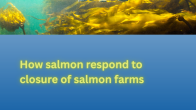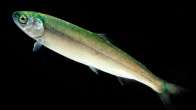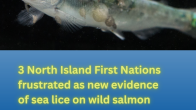Industrial fish meal and fish oil fisheries
Fishing to feed farmed salmon is taking food away from people and the oceanic food web.
Salmon require other fish in their diet and right now, farming salmon uses more fish protein than it produces. It takes more than one kilogram of wild fish to grow one kilogram of farmed salmon. Farmed salmon is a luxury food not intended to combat global hunger and some scientists claim it would be better to feed the fish being used to make salmon feed directly to hungry people.
Farmed salmon are no different from their wild cousins in that they require a certain amount of animal protein in their diet to stay healthy and grow. This protein comes from the harvest of forage fish species for reduction into fish meal and fish oil. Forage fish such as anchoveta, capelin, herring, menhaden and sardines are important food sources for many other marine species further up the food chain. Along with other fish, 98 percent of the anchoveta stocks harvested in Peru and 85 percent of sardines harvested in Mexico’s Gulf of California are currently being made into fish meal and fish oil mostly used for animal feed. In 2006 it was estimated that the global aquaculture industry utilized 68.2 percent of fish meal supplies worldwide or 3.724 million tonnes and 88.5 percent of fish oil supplies or 835,000 tonnes. From the same report, the global landings of forage fish in 2008 was 31.5 million tons with 90% of which is destined to the fish meal and oil industry.
Even though aquaculturists are researching ways to reduce their dependence on fish meal and fish oil and are actually improving the ratio of forage fish inputs per unit of farmed fish produced, many wild fish stocks around the world, including some forage fish stocks, are in decline. It remains to be seen whether farming carnivorous species like salmon can continue to meet the growing demand for seafood without putting more pressure on supplies of fish meal and fish oil.
The industrial fisheries for forage fish claim that they are harvesting sustainably. Populations of forage fish fluctuate dramatically from year to year making it difficult to assess whether or not these industrial fisheries are maintaining the health of the stocks. Harvesting also has an impact on the rest of the species in surrounding areas. By removing these important fish from the food web – 85 percent of the Peruvian anchoveta stocks are harvested every year – industrial fishing depletes the local marine ecosystem leaving it less stable. Fish meal and fish oil production is also impacting the health of the people living in communities near the reduction plants. Some ways to meet the growing global demand for seafood without increasing pressure on forage fish stocks is to focus our consumption of aquaculture products on shellfish and non-carnivorous fin fish species like tilapia and to re-direct some of the forage fish stocks destined for reduction to direct human consumption. An innovative program in Peru has increased human consumption of anchoveta by 285 percent in five years from 35,000 metric tonnes in 2006 to 100,000 tonnes in 2010 through increased and creative marketing of processed and frozen anchoveta products. Another option for reducing our dependency on fish meal and fish oil is to reduce our consumption of animal-based food products altogether and replace those with vegetable-based products.






